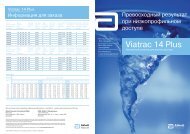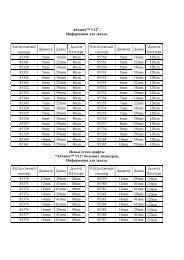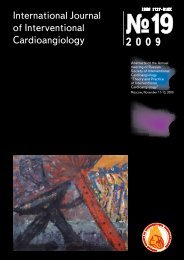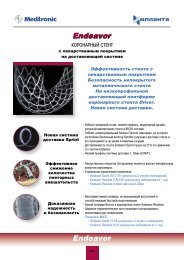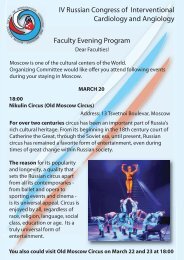Results of Coronary Stenting using the Stents with
Results of Coronary Stenting using the Stents with
Results of Coronary Stenting using the Stents with
Create successful ePaper yourself
Turn your PDF publications into a flip-book with our unique Google optimized e-Paper software.
Interventional cardiology<br />
(21,5 %) — <strong>of</strong> class III and 7 (13,7 %) — <strong>of</strong><br />
functional class IV. Unstable angina was<br />
seen in 6 (11,7%) patients. In Group 2<br />
painless ischemia was observed in 5 patients<br />
(7,6%). In total, 48 patients in <strong>the</strong><br />
control group (72,7%) were in heart failure.<br />
Among <strong>the</strong>m 9 (13,6 %) had heart<br />
failure <strong>of</strong> functional class I, 20 (30,3%) —<br />
<strong>of</strong> class II, 12 (18,2 %) — <strong>of</strong> class III and 7<br />
(10,6%) — <strong>of</strong> functional class IV. That is,<br />
both groups were highly homogenous by<br />
<strong>the</strong>ir functional class <strong>of</strong> angina, and statistical<br />
analysis did not reveal significant differences.<br />
A statistically significant difference<br />
have been revealed among patients <strong>with</strong><br />
ST-elevation myocardial infarction (STEMI).<br />
In Group 1 <strong>the</strong>re were 7 patients admitted<br />
<strong>with</strong> <strong>the</strong> diagnosis <strong>of</strong> MI. Among <strong>the</strong>m 1<br />
patient had non ST-elevation MI and 6 had<br />
PIVB<br />
RCA<br />
OMB<br />
CxB<br />
STEMI. In Group 2, MI has been diagnosed at admission<br />
in 5 patients, 2 <strong>of</strong> <strong>the</strong>m had non ST-elevation MI<br />
and 3 had STEMI.<br />
The diagram № 1 shows <strong>the</strong> distribution <strong>of</strong> target<br />
arteries in <strong>the</strong> groups.<br />
Statistical analysis<br />
Statistical analysis <strong>of</strong> <strong>the</strong> quantitative data was<br />
carried out <strong>with</strong> <strong>the</strong> use <strong>of</strong> non-parametric methods<br />
— Wilcoxon-Mann-Whitney criterion and Wilcoxon<br />
signed-ranks test for matched pairs. If <strong>the</strong><br />
amount <strong>of</strong> data in <strong>the</strong> compared groups was under<br />
30 and in at least in one group it was under 5, <strong>the</strong><br />
results have been compared <strong>using</strong> exact Fisher test<br />
(8, 9, 10).<br />
<strong>Results</strong><br />
Early results. Final clinical success <strong>of</strong> <strong>the</strong> PCI as<br />
well as final optimal angiographic results have been<br />
obtained in 100 % <strong>of</strong> cases in both groups. In Group 1<br />
(n=51) <strong>the</strong> complications occurred at different stages<br />
<strong>of</strong> <strong>the</strong> stenting procedure in 4 patients. In 1 case<br />
<strong>the</strong>re was a dissection along <strong>the</strong> distal edge <strong>of</strong> <strong>the</strong><br />
stent requiring an additional stent implantation. In<br />
ano<strong>the</strong>r case <strong>the</strong> development <strong>of</strong> “no-reflow” phenomenon<br />
inhibited <strong>the</strong> antegrade filling <strong>of</strong> <strong>the</strong> vessel.<br />
«No-reflow» could be stopped by intracoronary<br />
nitroglycerin. The implantation <strong>of</strong> an additional stent<br />
was not necessary. Also 2 patients (3,92%) from this<br />
group had a subcutaneous hematoma at <strong>the</strong> puncture<br />
site, not requiring blood transfusion.<br />
In Group 2 (n=66) <strong>the</strong> stenting-related complications<br />
developed in 3 patients. In one case <strong>the</strong> intimal<br />
damage distal to <strong>the</strong> target lesion in <strong>the</strong> territory <strong>of</strong><br />
<strong>the</strong> stented artery, occurring during guidewire positioning,<br />
led to this artery thrombosis. After <strong>the</strong> administration<br />
<strong>of</strong> IIb/IIIa platelet receptors inhibitiors<br />
<strong>the</strong> thrombus was lysed and an additional stent has<br />
been implanted <strong>with</strong> good results (<strong>the</strong> MI did not<br />
develop). One patient had a subcutaneous hematoma<br />
<strong>with</strong> <strong>the</strong> signs <strong>of</strong> post-hemorrhagic anemia (not<br />
DB<br />
LAD<br />
Group 2, n=66<br />
Group 1, n=51<br />
0 20 40 60 80<br />
Diagram № 1. Involved (target) coronary arteries in <strong>the</strong> studied<br />
groups<br />
requiring blood transfusion). Ano<strong>the</strong>r patient had a<br />
transient acute cerebrovascular accident, which was<br />
completely stopped in <strong>the</strong> intensive care unit in 2<br />
hours after <strong>the</strong> procedure.<br />
There were no o<strong>the</strong>r complications, including<br />
deaths, in <strong>the</strong> studied groups. The analysis <strong>of</strong> <strong>the</strong> immediate<br />
results revealed <strong>the</strong> absence <strong>of</strong> significant<br />
differences in <strong>the</strong> prevalence <strong>of</strong> complications between<br />
<strong>the</strong> groups (р>0,05) (table №3).<br />
All patients were discharged in stable condition<br />
<strong>with</strong> <strong>the</strong> recommendations for fur<strong>the</strong>r medical<br />
<strong>the</strong>rapy.<br />
Mid-term results <strong>of</strong> endovascular treatment.<br />
The duration <strong>of</strong> mid-term follow-up in <strong>the</strong> studied<br />
groups was 8,4 ±1,4 months for Group 1 and 8,1 ±1,7<br />
months for Group 2. The fate <strong>of</strong> all patients included<br />
into <strong>the</strong> study was known by <strong>the</strong> moment <strong>of</strong> control<br />
examination. According to <strong>the</strong> existing protocols <strong>the</strong><br />
patients underwent exercise testing for <strong>the</strong> detection<br />
<strong>of</strong> eventual myocardial ischemia and coronary<br />
angiography (95 patients). The data are presented in<br />
Table № 4.<br />
In <strong>the</strong> mid-term follow-up 51 patients (100%)<br />
from Group 1 and 65 patients (98,48%) from Group<br />
2 underwent clinical examination. The evaluation<br />
<strong>of</strong> myocardial perfusion by <strong>the</strong> means <strong>of</strong> stresstesting<br />
did not reveal clinical signs <strong>of</strong> angina in 47<br />
patients (92,15%) from Group 1 and in 61 (93,8 %)<br />
patients from Group 2. Clinical signs <strong>of</strong> angina <strong>with</strong><br />
confirmed myocardial ischemia has been noted in 4<br />
(7,84%) patients from <strong>the</strong> Group 1 and in 3 (4,54%)<br />
patients from <strong>the</strong> control group. All patients <strong>with</strong><br />
clinical signs <strong>of</strong> angina underwent coronary angiography.<br />
Control coronary angiography in <strong>the</strong> mid-term<br />
follow-up has been performed in 42 patients (82 %)<br />
from Group1, who received 94 stents (85,5%), and in<br />
53 patients (80,3%) from Group 2, in whom 76 stents<br />
(79,2%) had been implanted. The results <strong>of</strong> coronary<br />
angiography allowed for <strong>the</strong> assessment <strong>of</strong> such pa-<br />
%<br />
18<br />
(№ 26, 2011)




